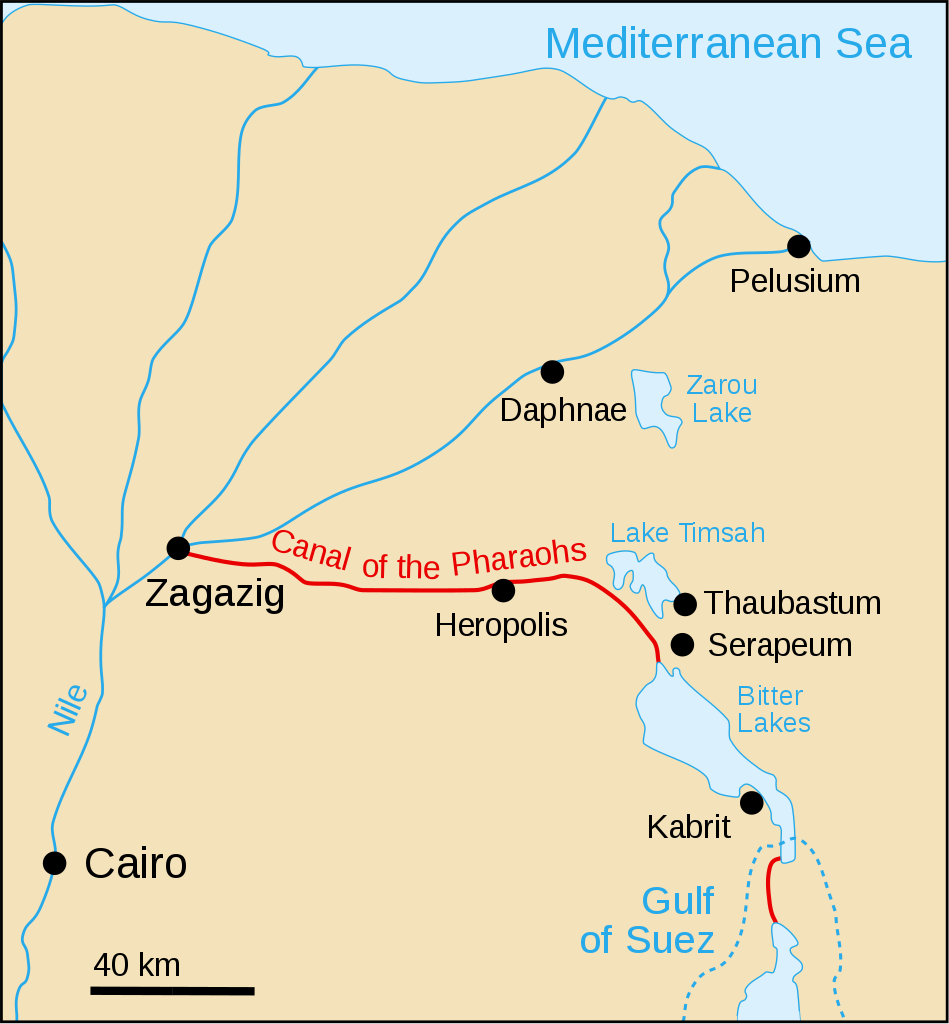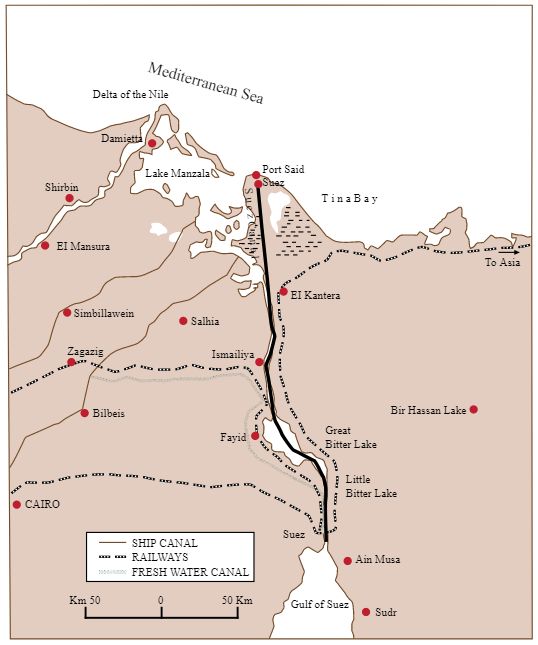The Suez Canal may be a marvel of modern engineering, but there is nothing modern about digging canals. Navigable waterways have been dug since ancient times, even across deserts in Northern Africa. The Suez Canal is only the most recent of these manmade waterways that once snaked their way across Egypt. Dug under the patronage of different Egyptian pharaohs under different time periods, they connected—unlike their modern version—the Red Sea with the Nile River.

Canal of the Pharaohs. Image by annie brocolie/Wikimedia Commons
According to Aristotle, the first attempt to dig a canal connecting the Red Sea and the Nile River was made by the legendary Egyptian Pharaoh Sesostris (who could either be Senusret III of the 12th Dynasty, circa 1800 BC, or Ramesses II of the much later 19th Dynasty, circa 1200 BC). Aristotle also notes that construction of the canal was stopped when the pharaoh discovered “that the sea was higher than the land”. The pharaoh feared that opening the Nile River to the Red Sea would cause the salty sea water to flow back into the river and spoil the Egyptian’s most important source of hydration.
According to Greek historians Strabo and Diodorus Siculus, after Sesostris, work on the canal was continued by Necho II in the late 6th century BC, but he did not live to see the canal completed. Later, Darius the Great picked up from where Necho II left, but like Sesostris, he too stopped short of the Red Sea when he was informed that the Red Sea was at a higher level and would submerge the land if an opening was made. It was finally Ptolemy II who finished the canal connecting Nile with the Red Sea. According to Strabo the canal was nearly 50 meters wide and of sufficient depth to float large ships. It began at the village of Phacusa and traversed the Bitter Lakes, emptying into the Gulf or Arabia near the the city of Cleopatris.

Route of the modern Suez Canal. Image: NCERT
However, according to Herodotus, the canal was completed by Darius and that it was wide enough for two triremes to pass each other with oars extended. By Darius's time a natural waterway passage possibly existed between Bitter Lakes and the Red Sea, but it had become blocked with silt. Darius, employing a vast army of slaves, cleared it out so as to allow navigation once again. Darius was so pleased with the results and with himself that he left several inscriptions on pink granite boasting of this accomplishment. One of these inscription discovered in the mid-19th century read:
King Darius says: I am a Persian; setting out from Persia I conquered Egypt. I ordered to dig this canal from the river that is called Nile and flows in Egypt, to the sea that begins in Persia. Therefore, when this canal had been dug as I had ordered, ships went from Egypt through this canal to Persia, as I had intended.
In the late 19th century, another stela called the ‘Stone of Pithom’ provides evidence that Ptolemy constructed a navigable lock, with sluices, at the Heroopolite Gulf of the Red Sea, which allowed the passage of vessels but prevented salt water from the Red Sea from mingling with the fresh water in the canal. There is evidence that in ancient times the Red Sea and its Gulf of Suez extended as far northward as the Bitter Lakes of Egypt. The Red Sea has gradually receded away over the centuries, with its coastline slowly moving southward away from Lake Timsah and the Great Bitter Lake, so that two hundred years later, the eastern end of the canal that opened in the Red Sea became chocked with silt.
Also Read: How War Marooned 15 Ships in The Suez Canal For Eight Years
The canal existed in one form or the other up to the 8th century, until it was closed shut by the Abbasid Caliph al-Mansur in 767 to prevent his enemies and rebels from using the canal to ship men and supplies from Egypt to his detractors in Arabia. Lack of maintenance caused the canal to slit up and it disappeared into the desert and from people’s memory as well.

The Suez Canal in 1869. Engraving from "Appleton's Journal of Popular Literature, Science, and Art", Wikimedia Commons
The canal was rediscovered by Napoleon in 1798 during the French campaign in Egypt and Syria. Napoleon had its motives to search for the canal, because if the canal could be reconstructed it would allow France to monopolize trade with India. With this design Napoleon instructed his chief civil engineer, Jacques-Marie Le Pére, to make a topographical survey of the Isthmus of Suez while looking for vestiges of the ancient canal. Le Pére and his fellow engineers were able to follow and eventually trace the “Canal of the Pharaohs” from the Red Sea all the way to the Nile. Later, when Napoleon became the Emperor, he asked his chief engineer to find a way to reopen the canal, but Le Père, like his predecessors two thousand years ago, erroneously reported to Napoleon that the Red Sea was higher than the Mediterranean, and locks would be needed to prevent a catastrophic mingling of waters.
Construction of the Suez Canal wouldn't begin until fifty years later in 1859. Excavation was conducted using forced labor, just like under the pharaohs. Some sources estimated that tens of thousands of laborers died from diseases such as cholera and other epidemics, although a conservative estimate puts death at fewer than 3,000. The canal has no locks, for the sea level is the same. Its route, unlike the “Canal of the Pharaohs” goes through the isthmus passing through the Great Bitter Lakes northward until it opens in the Mediterranean near the port city of Suez.



Very interesting
ReplyDelete